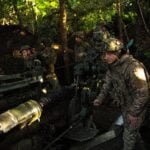Seoul, South Korea — The South Korean military said Wednesday North Korea launched the highest number of short-range missiles in a day as Seoul retaliated to Pyongyang’s latest barrage of weapons tests, further escalating tensions in the region.
North Korea fired as many as 23 missiles of different types to the east and west of the Korean Peninsula, including a surface-to-air missile into the waters off the east and west coasts of the Korean Peninsula, according to the South Korean Defense Ministry.
One of the missiles launched by Pyongyang was a short-range ballistic missile that landed close to South Korean territorial waters for the first time since the division of Korea, Seoul’s Joint Chiefs of Staff (JCS) said.
JCS said the missile landed in international waters 167 kilometers (104 miles) northwest of South Korea’s Ulleung island, about 26 kilometers south of the Northern Limit Line (NLL) – the de facto inter-Korean maritime border that North Korea does not recognize.
Japan’s Defense Ministry said North Korea conducted another launch later on Wednesday, including at least one more ballistic missile toward the east that has fallen into the sea outside of Japan’s Exclusive Economic Zone (EEZ).
The ballistic missile flew a short distance at a maximum altitude of less than 50 km, Toshiro Ino, the deputy minister of defense, told reporters on Wednesday evening local time.
“North Korea has rapidly escalated its provocations, launching more than a dozen missiles today alone and reportedly firing more than 100 artillery shells into the Japan sea since announcing an extremely provocative statement earlier in the day” Ino said.
No damage to aircraft or vessels has been confirmed as of now.
When asked whether North Korea had in the past launched this many missiles throughout a day, Ino told reporters that in 2006 and 2009 the North had fired several missiles throughout the day from 3 a.m. to 5 p.m. local time, and 8 a.m. to 5:30 p.m. local time, respectively, without mentioning an exact number of missiles.
A South Korean defense official said earlier the missiles landed to the west of the peninsula in the Yellow Sea, known as the West Sea in Korea, and to the east in the Sea of Japan, also known as the East Sea.
An air raid warning on Ulleung island, located about 120 kilometers east of the peninsula, was lifted about 2 p.m. local time on Wednesday. South Korean President Yoon Suk Yeol said the North Korean test was an “effective territorial encroachment.”
At an emergency National Security Council (NSC) meeting, Yoon “ordered that a stern response be swiftly taken so that North Korea’s provocation pays a clear price,” according to South Korea’s presidential office.
In an immediate response, South Korea launched three air-to-surface missiles from F-15K and KF-16 fighter jets on Wednesday morning, according to JCS.
JCS said the South Korean Air Force targeted international waters north of the NLL at an equal distance to that which the North Korean missile had earlier landed south of the line.
“Our military’s precise strike showed our will to firmly respond to any North Korean provocations including short-range ballistic missile, and our capability and readiness to precisely target the enemy,” JCS said.
North Korea is “fully responsible” for the situation as they are the ones continuing to provoke despite warnings, JCS added.
On Wednesday, Japanese Prime Minister Fumio Kishida told reporters that North Korea is launching missiles at an “unprecedentedly high frequency.”
Kishida also called for a National Security Council meeting to be held as soon as possible due to the rising tensions on the Korean Peninsula.
“North Korea’s unprecedented launch of multiple ballistic missiles is recklessly threatening the security of the Republic of Korea,” Australian Foreign Affairs Minister, Penny Wong, tweeted on Wednesday.
“Pyongyang must cease this action,” she added.
Moscow urged North and South Korea to avoid steps that “could provoke a further increase in tension,” as it contends with fractured global relations amid Russian President Vladimir Putin’s brutal invasion of Ukraine.
“The situation is already very tense on the peninsula, and we urge everyone to remain calm and avoid steps that could provoke a further increase,” Kremlin spokesperson Dmitry Peskov said on Wednesday.
US Ambassador to the UN Linda Thomas-Greenfield condemned North Korea’s unprecedented missile launch overnight.
Thomas-Greenfield told CNN on This Morning with Don Lemon, Kaitlan Collins and Poppy Harlow that the launch breaks “multiple Security Council resolutions” and said the UN would be “putting pressure” on China and Russia to improve and enhance such sanctions.
She declined to say whether US President Joe Biden would raise it with China’s President Xi at the G20, but added it was “on the President’s mind.”
Rising tensions
The launch is North Korea’s 29th this year, according to a CNN count, and comes after a North Korean official warned in a statement earlier Wednesday that the United States and South Korea would pay the “most horrible price in history” for any military action against Pyongyang.
The aggressive acceleration in weapons testing and rhetoric has sparked alarm in the region, with the US, South Korea and Japan responding with missile launches and joint military exercises.
On Monday, the United States and South Korea began previously scheduled large-scale military exercises called “Vigilant Storm.”
The maneuvers involve 240 aircraft and “thousands of service members” from both countries, according to the US Defense Department.
US Defense Secretary Lloyd Austin is scheduled to meet with his South Korean counterpart Lee Jong-sup at the Pentagon on Thursday.
Experts have previously told CNN that North Korean leader Kim Jong Un could be sending a message by deliberately showcasing the nation’s arsenal during a period of heightened global conflict.
Last month, North Korean state media broke six months of silence over this year’s spate of missile tests, claiming they were meant to demonstrate Pyongyang’s readiness to fire tactical nuclear warheads at potential targets in the South.
The latest tests also come after the head of the United Nations’ nuclear watchdog warned last week that Pyongyang could be preparing for a nuclear test – its first since 2017 – with satellite imagery showing activity at its underground nuclear test site.
“We are following this very, very closely. We hope it doesn’t happen but indications unfortunately go in another direction,” said International Atomic Energy Agency chief Rafael Grossi last Thursday.












